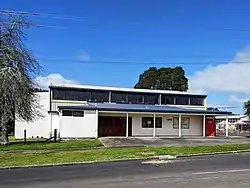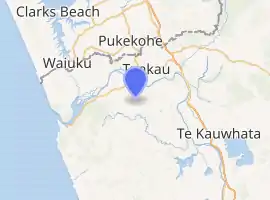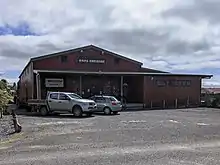Onewhero
Onewhero is a village and rural community in the Waikato District and Waikato region of New Zealand's North Island. The village had a population of about 390 in the 2018 New Zealand census;[1]
Onewhero | |
|---|---|
 School and Community hall | |

| |
| Coordinates: | |
| Country | New Zealand |
| Region | Waikato |
| District | Waikato |
| Population (2018) | |
| • Total | 390 |
Pukekohe and Tuakau are located north of Onewhero, across the Waikato River;
The name Onewhero translates from Maori as "Red Earth", which describes the soil colour typical in the Franklin region.[2]
The Onewhero village consists of an Anglican church, school, fire station, garage, lawn bowls club and tennis club. The Onewhero Society of Performing Arts runs a local performing arts theatre, and the local rugby club hosts community events and community board meetings.[3] The Onewhero Golf Club is located in nearby Pukekawa.
The local Te Awamārah marae is a meeting ground for the Waikato Tainui hapū of Ngāti Āmaru, Ngāti Pou and Ngāti Tiipa.[4] It includes the wharenui (meeting house) of Whare Wōnanga.[5]
Demographics
| Year | Pop. | ±% p.a. |
|---|---|---|
| 2006 | 1,485 | — |
| 2013 | 1,542 | +0.54% |
| 2018 | 1,605 | +0.80% |
| Source: [6] | ||

The statistical area of Onewhero, which at 205 square kilometres is much larger than the village and also includes Te Kohanga, had a population of 1,605 at the 2018 New Zealand census, an increase of 63 people (4.1%) since the 2013 census, and an increase of 120 people (8.1%) since the 2006 census. There were 552 households. There were 822 males and 783 females, giving a sex ratio of 1.05 males per female. The median age was 40.8 years, with 357 people (22.2%) aged under 15 years, 243 (15.1%) aged 15 to 29, 813 (50.7%) aged 30 to 64, and 189 (11.8%) aged 65 or older.
Ethnicities were 83.4% European/Pākehā, 21.5% Māori, 3.7% Pacific peoples, 4.3% Asian, and 1.3% other ethnicities (totals add to more than 100% since people could identify with multiple ethnicities).
The proportion of people born overseas was 18.5%, compared with 27.1% nationally.
Although some people objected to giving their religion, 56.4% had no religion, 30.5% were Christian, 0.7% were Hindu, 0.0% were Muslim, 0.2% were Buddhist and 2.8% had other religions.
Of those at least 15 years old, 216 (17.3%) people had a bachelor or higher degree, and 234 (18.8%) people had no formal qualifications. The median income was $37,600. The employment status of those at least 15 was that 738 (59.1%) people were employed full-time, 186 (14.9%) were part-time, and 42 (3.4%) were unemployed.[6]
Education
The main school is Onewhero Area School, which serves from Years 1 to 13.[7] with a roll of 542 as of March 2020.[8] There is also a pre-school for children under 5 years.
References
- "Meshblock Electoral Populations 2020 for proposed boundaries data". Statistics New Zealand. April 2020. Meshblocks 0844700 and 0844500.
- "1000 Māori place names". New Zealand Ministry for Culture and Heritage. 6 August 2019.
- "Onewhero-Tuakau Community Board". www.waikatodistrict.govt.nz. Retrieved 5 June 2016.
- "Te Kāhui Māngai directory". tkm.govt.nz. Te Puni Kōkiri.
- "Māori Maps". maorimaps.com. Te Potiki National Trust.
- "Statistical area 1 dataset for 2018 Census". Statistics New Zealand. March 2020. Onewhero (170100). 2018 Census place summary: Onewhero
- Education Counts: Onewhero Area School
- "New Zealand Schools Directory". New Zealand Ministry of Education. Retrieved 26 April 2020.
